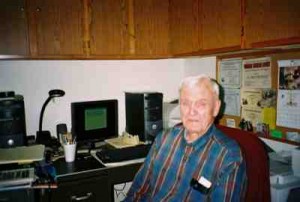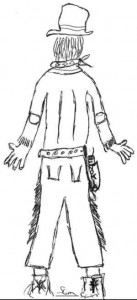Review by Ed Quillen
History – September 2005 – Colorado Central Magazine
Crofutt’s Grip-Sack Guide of Colorado
by George A. Crofutt
Originally Published in 1881
Revised Version Published in 1885
Republished in 1966 and 1981 by Johnson Books 1885 version Republished on CD-ROM in 2005 by the SoftEase Company
ISBN 0933472560
I WAS ABOUT nine years old when I first heard of Crofutt’s Grip-Sack Guide of Colorado. Since I was fascinated by old mines and mining camps, my parents gave me a wonderful birthday present, Murial Sibelle Wolle’s Stampede to Timberline. Therein the author said that the Grip-Sack Guide was often the only source for information on many of Colorado’s short-lived settlements; even then, I wanted a copy.
There are a lot of things I want and don’t get, but the Guide was an exception. Three Golden men — Francis B. Rizzari, Richard A. Ronzio, and Charles S. Ryland — reprinted the 1885 guide in 1966, and brought out a 1980 edition with a large collection of 1880s photographs. I bought the first one I saw, and it’s been a cherished reference ever since.
Alas, even that rendition is long out of print. But it’s available now on compact disk, thanks to W. Michel Kiteley of Longmont. Since the 1885 book is long out of copyright, he was able to scan the Johnson reprint and put it in Adobe Portable Document Format (PDF) on a CD that you can just pop into your computer.
All you need is a CD reader and Adobe Acrobat Reader, which is free, and there’s a Windows version on the CD. Acrobat Reader is also available for Mac and Linux systems. My Linux box (SuSE 9.1) handled it just fine, and it worked easily on two Windows machines at hand, one running XP Pro and the other Win 98.
(In general, I prefer plain old books to electronic media, and the preceding paragraph is one reason for this prejudice. Can you imagine a review of a regular bound paper book wherein the reviewer thought it necessary to write that “I tried this text under incandescent light, fluorescent light, lantern light, candles, and natural outdoor sunlight, and it was readable in all those circumstances.” The digital age still has a ways to go.)
Not much is known of George Croffut, who was born in Connecticut in 1827, and died sometime after 1905, probably in Denver. He traveled widely in the United States and practiced many trades, from freighting to engineering, and he wrote many guidebooks, starting in 1869 with one for the new transcontinental railroad. He also wrote extensively about mining and railroads.
As Kiteley explains in his CD introduction, Croffut provides a “snapshot” of Colorado in 1885. The book starts with some short general descriptions, covering the agricultural and mineral prospects of Colorado during its first decade of statehood. He also covers “Current Wages in Colorado,” where we learn that blacksmiths earned $2 to $3 a day, while stonecutters got $4 and “dining-room girls” received “$20 to $30 per month and board.”
Most of the book is taken up with eight tours, each following a different railroad route, followed by an alphabetical listing of “Condensed Descriptions of Every City, Town, Village, Station, Medicinal Spring, Resort, and Important Mining Camp in the State.”
Of most interest in Central Colorado are Tour Five (“Platte , Canon, Alpine Tunnel, Gunnison”), and Tour Six (“Manitou, Royal Gorge, Marshall Pass.”)
Here’s a sample from Tour Five:
From Buena Vista our route to the Gunnison and San Juan country is down the west bank of the Arkansas river, seven miles to Nathrop, thence directly west, up Chalk creek five miles, to HAYWOOD SPRINGS, one mile further to HORTENSE. At both of the last named stations are situated hot springs, of which more hereafter.
From Hortense it is four miles to ALPINE. From a short distance west of Nathrop the road is built along the creek, with high bluffs on both sides; the distance between the bluffs has been gradually narrowing, until above Hortense the contraction takes the shape of a mountain gorge, and well it may, as Mt. Princeton rises from the water’s edge on the north to an altitude of 14,199 feet, while on the south and directly opposite towers Mt. Antero, 14,245 feet, while beyond, only a short distance, is Mt. Shavano,14,239 feet.
FOREST CITY and St. Elmo are reached four miles above Alpine. where are located mineral veins of great prospective value. Five miles further, through scenery most grand and diversified, we reach the thriving town of
HANCOCK. This place is situated away up on the eastern slope of the Sawatch, or main chain of the Rocky mountains, at an altitude of 10,919 feet above sea level. It is a mining town three miles east from the entrance to the world-renowned
ALPINE TUNNEL. This remarkable piece of work, the result of fine engineering skill and “Paddy’s brawny arms,” is 11,523 feet above the level of the sea–above “timber line,” above where trees and vegetation grow, or animal life is found; all is rocks, little rocks, big rocks, and rocks of every shape and dimension, where the air is pure and thin, where at times the charming zephyr plays seductive airs, and anon the blizzard sports such pranks as tend to “bull the stock” of the inferno.
This tunnel is 1,830 in length, 14 feet in width, 17 in height, and with one exception it is the highest point in the world reached by steam cars. In passing through you are transferred from the Atlantic to the Pacific slope, here the view changes. On the left, and rising perpendicularly, are the mountains along which our roadway has been blasted from the solid rock. From the high shelf and palisade thus formed is an appalling depth terminating away down in the valley into which there is a gradual, sinuous descent, while the surrounding natural wonders are indescribable.
In case you’re curious about how Croffut describes towns when he’s not taking you on a tour, here’s his take on Saguache:
Saguache–Seat of Saguache county, [pronounced Siwach] is situated in the northern portion of San Luis valley, in a stock-raising and farming community. On the Saguache river, which comes down from Cochetopa hills to the northwest, are some fine farms, where wheat and vegetables are raised very successfully. Hay is put up in large quantities and hauled to the mining towns, where it sells at from $50 to $100 per ton. Sheep and cattle-raising, however, are the principal occupations of the settlers, about one-half of whom are Spanish-Mexicans, and live in adobe houses, surrounded by cattle, sheep, goats, babies and dogs. The town consists principally of adobe and log buildings, yet there are a few good brick and stone buildings for business purposes, and a few good wooden private residences.
Recent reports locate rich mines in the mountains near, to the northward, but developments are not such that definite figures can be given. The town contains a bank, several good general merchandise stores, three hotels, the Exchange, Climes and New England, and two weekly newspapers, the Chronicle and the Advance. Villa Grove is the nearest railroad station, 20 miles east. Distance from Denver, 275 miles; fare, $14.05.–See Post Roads, No. 95. Tour Six.
AS YOU CAN TELL, Croffut was prejudiced against non-Anglo residents of Colorado; it really shows in his description of the town of Meeker, near the site of the 1879 Ute uprising: “If the government desires the lands occupied by the Indians, let it stop making treaties, take possession of them, then lay down a policy well backed with the power to enforce it, place the Indians in the alms houses, together with the 80,000 foreign born that now occupy them, where, should further massacres occur, the government would be the gainer.”
Name any Colorado spot that you’ve ever heard of, and if it was around in 1885 (thus no Creede or Cripple Creek), it’s almost certainly in Croffut. Cleora (now the site of the stockyards just east of Salida) was “54 miles west from Cañon City, and two miles south from South Arkansas, on the Denver & Rio Grande railway. This was once a place of ‘great expectations,’ but is now almost deserted. Distance from Denver, 215 miles; fare $9.20.”
TO MY MILD SURPRISE, South Arkansas was listed separately from Salida; I’d always thought they were one and the same, but South Arkansas “is about half a mile south from Salida.” Some spellings and place names have changed in 120 years: Poncha Springs was Poncho Springs then, Pueblo was “The Pueblos,” and Crestone was Creston, with “a general store, reduction works, and about 200 population, engaged in mining, farming, and stock-raising.” I could write interminably about the joys of browsing through Croffut; it’s a paradise for a Colorado history buff.
As for the CD, as compared to the book, there are some advantages. It’s easy to search for text and the wood-cut pictures are of such resolution that they can be enlarged to show details that are hard to spot in the book. Also, it’s simple to copy text into something you’re writing.
By putting this entertaining and informative old book on CD, and generally following the typography and format of the original. Michel Kiteley has done a wonderful thing for all Colorado history buffs — making sure that Croffut stays available.
If you don’t have the book, get this CD. And even if you do have the book, you’ll enjoy the CD — research is fast, and you’ll save wear and tear on the irreplaceable book.


